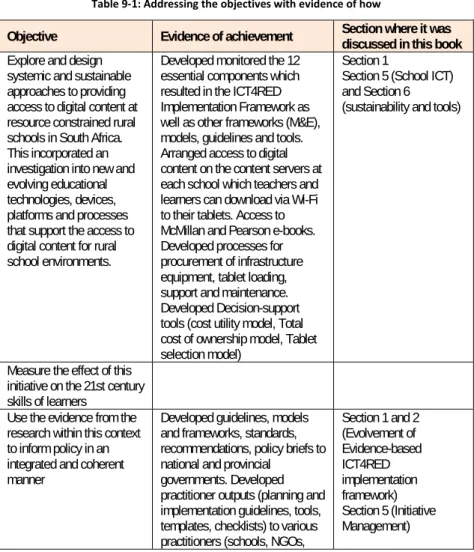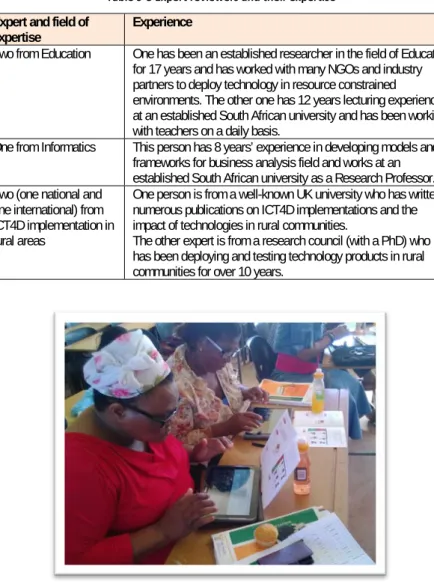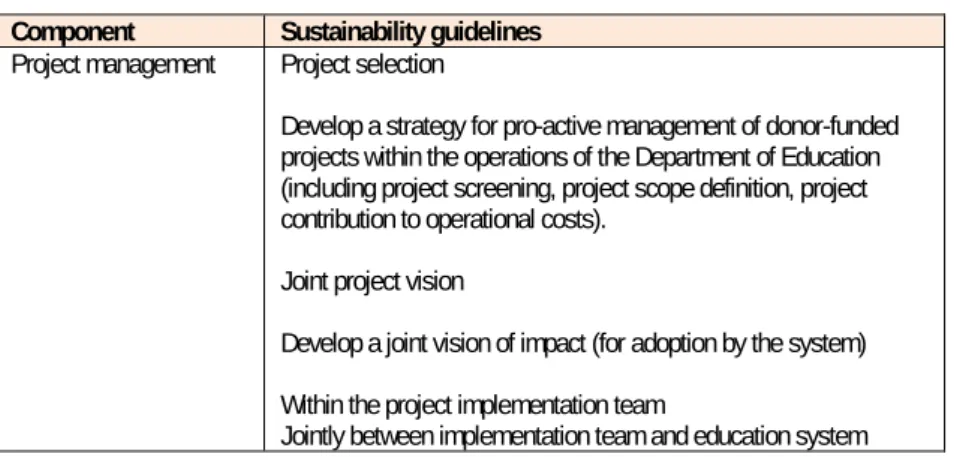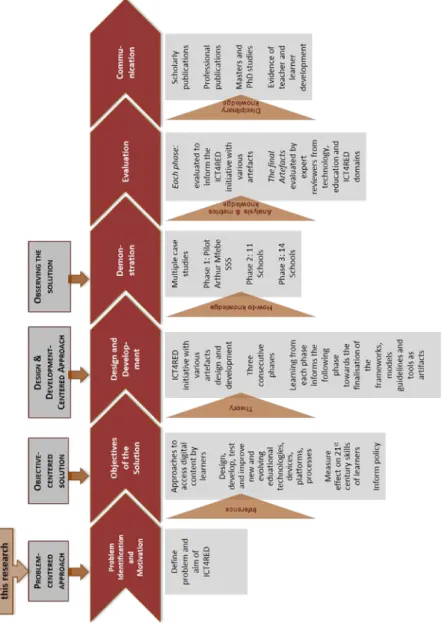Conceived by the ICT4RED initiative, this initiative was a research, development, innovation and implementation project that changed the way teachers teach with technology in their specific context over a period of 3 years. Created by the ICT4RED initiative, this intervention was a research, development and implementation project that changed the way teachers teach with technology in their specific context over a period of 3 years. The issue of sustainability and how it plays an important role in the ICT4RED initiative is discussed.
Synthesis of the ICT4RED initiative
Addressing the aim and objectives
The tablets enabled better planning, the establishment of an ICT committee for each school to decide on the use of tablets to support teaching and learning, and allowed teachers to be exposed to new ways of teaching with technology. Each school has an ICT champion to help them use the technologies. Some teachers excelled more than others, but all teachers earned their technology with evidence of successful use of instructional strategies.
Research and design systemic and sustainable approaches to providing access to digital content in resource-constrained rural schools in South Africa. This included an investigation of new and evolving educational technologies, devices, platforms and processes that support access to digital content for rural school settings. Objective Evidence of achievement Section where discussed in this book Explore and design.
Organized access to digital content on the content servers at each school that teachers and learners can download to their tablets via Wi-Fi. Objective Evidence of performance Section where it is discussed in this book provincial implementation. agencies, etc.).

What were the biggest success factors?
The learning of this initiative is designed to feed into the system in a multi-dimensional way, to a variety of stakeholders in the rural educational ecosystem. Teachers are more motivated and eager to learn more and have already requested additional training on specific topics not covered in the TPD training modules (such as internet use). These five can all be found in the ICT4RED initiative as openness and transparency were among the values communicated from the beginning.
Economic and social services were not measured, but it was observed that the initiative did provide support on a social level and on an economic level the district and principals were trained in the Change leadership courses to develop a vision and plan their budgets. The ICT4RED initiative supported sustainability from a socio-political perspective as all political leaders in the community (chiefs, tribal leaders etc.) were involved in community engagement meetings and workshops from start to finish. They felt that they were part of the initiative and their roles in the community were valued.
These are the controversial issues that may play a role in the future of this initiative. Issues related to sustainability for each of the 12 core components in the ICT4RED implementation framework will be discussed in section 9.7.
Other significant results
Synthesis of the ICT4RED initiative 284 . parents do not always have the resources to buy new tablets for their children, etc.). Schools all have an ICT committee that makes decisions about the use of technology in their school. All schools have an IT support person to help with bookings and maintenance and support of the technology in their schools.
The acquisition and use of technology has affected every person who was part of the initiative. Teachers are also using the tablets for administrative purposes, which are not included in any of the TPD training modules. The ICT4RED Initiative is contributing towards the Department of Science and Technology's Human Capital Development objectives: The ICT4RED Initiative is actively supporting 6 Master's degree students and 3 PhD students with funding for their studies, and 3 other Honors students, 2 postdoctoral students and a team from SAP research are also using the ICT4RED initiative in their research.
The ICT4RED initiative contributes to knowledge in areas such as ICT for education, rural development and evaluation. By 2015, the ICT4RED initiative had produced ten published papers in local and international conference proceedings, while other research results were in progress.
Challenges
Schools also report a change in the way the district interacts with them after the project started in their school. In particular, the officials involved in e-learning and institutional development visit schools more often and help with tasks such as coordinating training, helping to incorporate tablets into lessons, providing moral support and boosting teachers. The initiative did not focus on improving student outcomes, if this was the case the entire scope and objectives would have been different.
There are too many variables that could play a role in saying this initiative has had a positive impact on student outcomes. Financial Sustainability – ECDoE has asked ICT4RED to help with their budget so that operational costs can be integrated into the department budget. This is a major step forward in terms of the long-term financial sustainability of the initiative.
Electricity is a real challenge, both in terms of quality of electricity, cost of electricity as some schools use pre-paid and budget R100 per month.
Recommendations for further implementations
It also had the added benefit of very close supervision of the teachers and the team being able to intervene very quickly if problems arose. It is necessary to continue working with the district and the province on the integration of tablets in all processes at both levels. This is part of the research that needs to be done to determine what needs to be done to sustainably embed technologies into the system.
This includes a lot of work at national level, in terms of using the initiative's research findings to support policy and implementation. A particular need would be to continue monitoring and evaluation activities over the next two years, to measure the true impact of the initiative, once the larger ICT4RED initiative team has withdrawn. Due to the 'Earn while you learn' and phased implementation approach, the rollout of the various technologies has only taken place after schools have demonstrated that they are ready.
It provides opportunities for local content creators and entrepreneurs in terms of e-textbooks, videos, apps. Based on the above recommendations, it is also important to identify the sustainability issues related to each of the crucial 12 components in the implementation framework.
Recommendations relating to sustainability and policy It has been mentioned earlier in this section that having plans and It has been mentioned earlier in this section that having plans and
Develop a cost model (TCO model) and associated scenarios during the project planning phase in collaboration with the Ministry of Education. The TCO model should take into account the implementation of the project by the project team or department and should include, for example, the cost of replacing devices. Define a temporary implementation structure that gradually realizes the operational requirements of the implementation over the life of the project.
Facilitating the development of the structures and processes required to maintain implementation in delivery. Initiate a process of gradual handover of selected PM and project administration functions from project inception. Engage each school as a partner early on and facilitate handing over the community engagement role to them as soon as possible.
The latter could be led by a member of the circle (principals or district person) or by a new master. Facilitate a change in schools' policy as asset owners to ensure that long-term maintenance and replacement costs are covered by the province.
Evaluation
Change will be sustained if the capacity of the environment to adopt change is understood and planned for, and if the intervention is absorbed into the larger educational system. In practice, facilitating a sustainable intervention requires a holistic focus on understanding the capacity of the environment to adopt the intervention, creation of a temporary structure that implements the intervention in interaction with system owners, followed by negotiation of absorption of the project into the larger educational systems. Two from Education One has been an established researcher in the field of education for 17 years and has worked with many NGOs and industry partners to implement technology in resource-constrained environments.
The value of the processes and artefacts developed through the interdisciplinary DSR process provides sufficient evidence of how these were improved through different phases. The story of ICT4RED is a valuable resource for anyone from education to ICT4D practitioners and industry looking to replicate aspects of the initiative. The book as a descriptive narrative provides a high-level interpretation of the most important aspects to be taken into account in the diffusion of technology in schools in this context.
Feedback from experts supports the presentation and focus of all components in the initiative. If schools are the building blocks for learning and socialization, then the quality of the schooling system significantly affects further education and society.

Summary
But UNESCO Bangkok argues that to make successful use of ICT to increase the reach and quality of teaching and learning, policy makers must be aware of how ICT can be utilized in their country's education system, and must develop a supportive policy environment. to accommodate this.
Maggie Verster ni inzobere mu ikoranabuhanga mu burezi akaba n'umujyanama. Omashani Naidoo akomoka muri SchoolNET SA. Ubuyobozi bukora Kuva muri CSIR: Olwethu Qwabe, Nare Monwa, JP Tolmay, George Sibiya, Olalekan Ogunleye, Nic de Vries. Gukurikirana no gusuzuma CSIR: Charles Phiri, Nare Mahwai, Sifiso Dlamini, Thato Foko, Mmamakanya Rampa.
Neetworkii fi manneen barnootaa TQO Kiraayg Yaang (Liquid Telecom), Gert de Beer (Redline) Wessel Wessels (Hive Holdings); Fayyadama Etnograafii Ijaarsa Prof Nicola Bidwell fi Sifiso Dlamini. UP: Dr Ronel Callaghan fi gareen Living Labs Yunivarsiitii Pretoria, Candice Langenhoven, Marelet Moolman, Hendri Kruger, Lizanne van Zyl,. Roodis: Dr Kristiin Krause, Dr Kaarooliin Pade Khene, Gugulethu Baduza, Hafeni Mthoko, Kanya Nkula Yunivarsiitii Maanchistar: Jaakoo Reenken fi Prof Richard Heeks.

